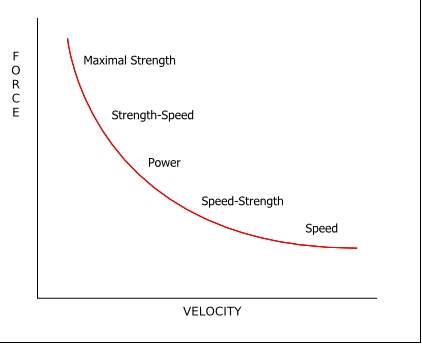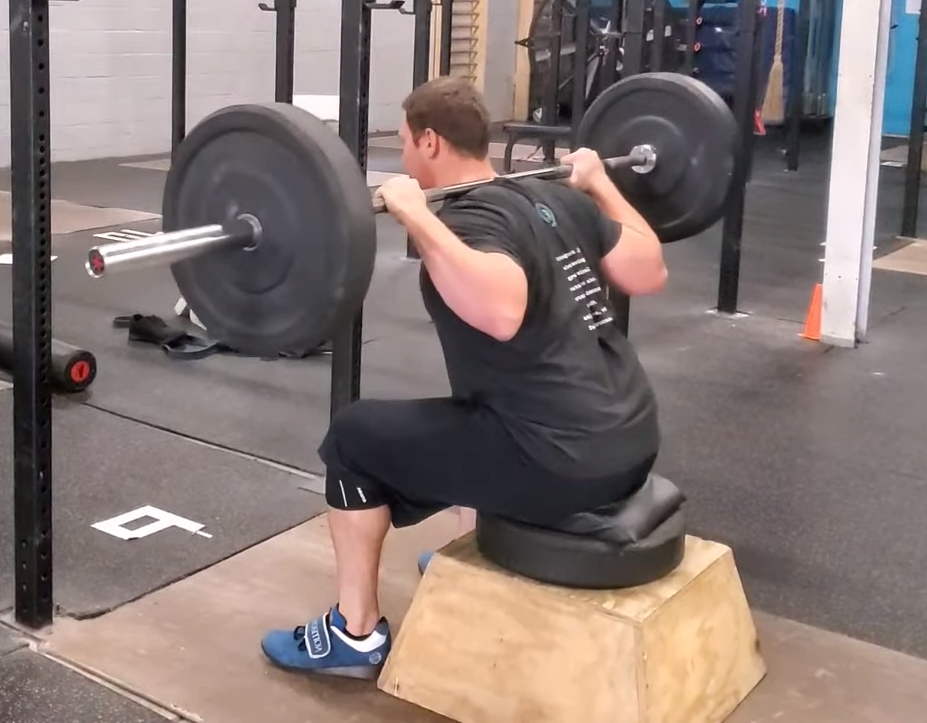Box Squat and Speed Work Days
by Erik Castigione
Our current strength cycle has box squats in it, which has prompted a couple questions from members. Why do we do them, and how do we do them properly? Let’s pretend that you’re a regular reader and actually read “What We Train: Part 3 – Strength.” In it, we covered the different types of strength that we train.
In the middle of the strength curve, we have power, which is defined as producing the most possible force in the shortest possible time. We train power and speed-strength in a few ways: with the Olympic lifts, plyometrics, and with our speed work days. For speed work, we start at 60%, and eventually increase up to 70%. These weights are PURPOSELY light. The goal for speed work, as the name implies, is to generate BAR SPEED. We can only accelerate the bar appropriately at lighter weights – when we get too close to max weight, we inevitably slow down.
Why do we care about bar speed? Because Force = Mass x Acceleration (F=MA), and Kinetic Energy = Mass x Velocity Squared (KE = MV2). Therefore, we get stronger by either moving more mass, or moving mass FASTER. If you’ve ever failed a squat or press, chances are you got stuck at some point in the lift and had to bail. If you can ACCELERATE through that sticking point, you’ll be successful. So, we need to train bar speed.
Enter speed work days. When we perform these, the goal is to move the lighter way as quickly as possible. This DOES NOT MEAN that we rush through our sets, the goal is not to finish our sets as fast as we can. Rather, we want to complete each individual rep as fast as we can. The distinction is subtle, but hugely important. If you can get through the set quickly as well without sacrificing form, even better. Keeping your sets to under 10 seconds when we perform them in an EMOM allows you to get some conditioning benefit as well – by training the phosphagen energy system.
Additionally, when it comes to generating lower body power, we separate the eccentric (negative/descending) and concentric (positive/ascending) portions of the lift. When doing speed deadlifts, we achieve this by having you reset on each rep rather than touch and go. For speed squats, we have you use a box – a properly executed box squat allows for this same separation.
Why separate the two parts? So that we don’t become reliant on what’s called the stretch-shortening cycle. Rather than bore you with the technical definition, just think about the “bounce” you get out of the hole when you squat. If you become super reliant on the bounce, you’re more likely to get stuck just above the hole, where the bounce ends. By forcing you to stop completely on a box, and then explode up, we are practicing maximal contraction right at this sticking point. In other words, we’re teaching you to accelerate through the entire ascent of the squat.
Hopefully the “why” behind box squats and speed days made sense, so now let’s talk about how to properly perform a box squat. As I just mentioned, the goal is to come to a complete stop on the box. We want you to maintain a tight core (back angle DOES NOT change), but relax your legs. Then, you FIRE your legs as hard as humanly possible to drive up off the box. It should look like this:
A common mistake in the box squat is to touch and go without relaxing the legs. If we don’t relax our legs, we don’t get the benefit of maximal contraction. We WANT you to go from 0-100%, it’s how we improve rate of force production (i.e. power).
Another common flaw is relaxing the torso as well as the lower body. This happens when we rock back excessively. It doesn’t matter if we’re doing low bar, high bar, Zercher, or front box squat variations, our back angle MUST NOT CHANGE. Doing so compromises your spinal integrity and is just plain dangerous.
To conclude: we use box squats (and speed work) to improve our power. Move lighter weights FAST to get the benefit of the exercise, which is all about bar speed. Going too heavy negates any benefit. Box squats require a tight core and constant back angle, but we need to relax the lower body and then contract as hard as possible. We do not touch and go during speed work. I hope this helps clear the air around speed days and box squats. See you in the gym.


